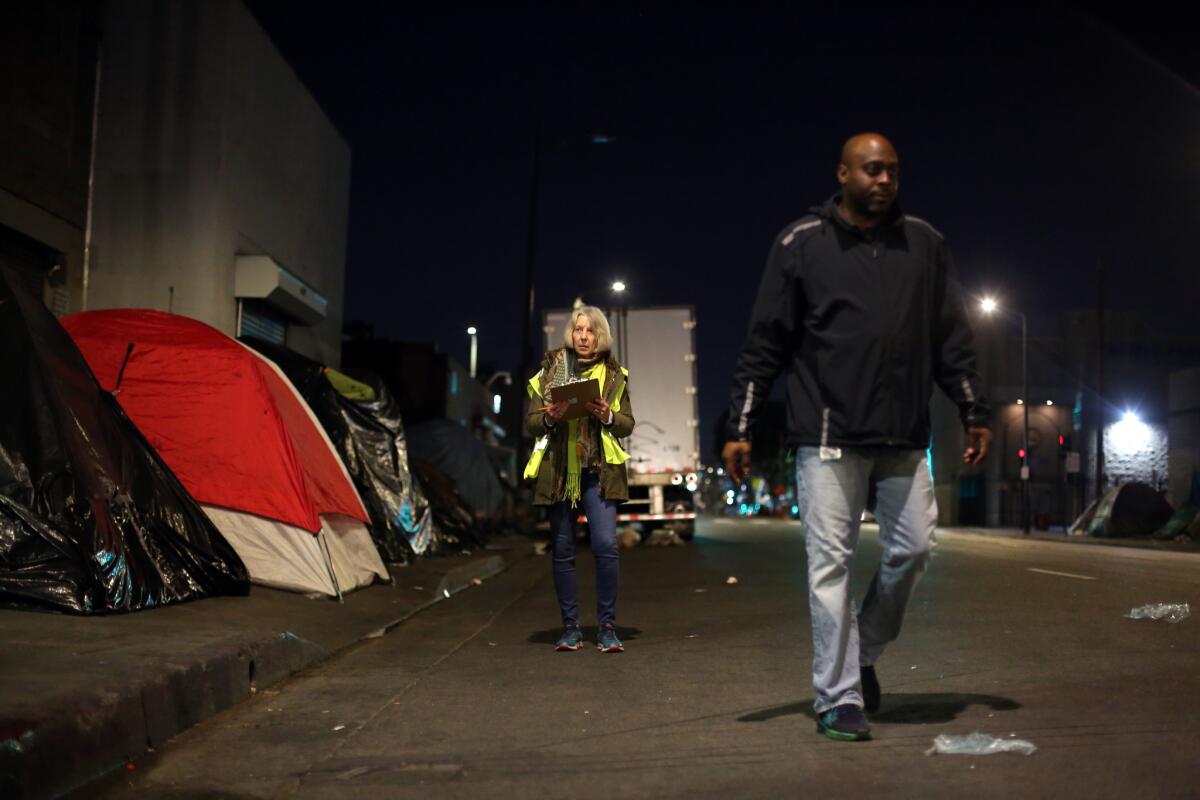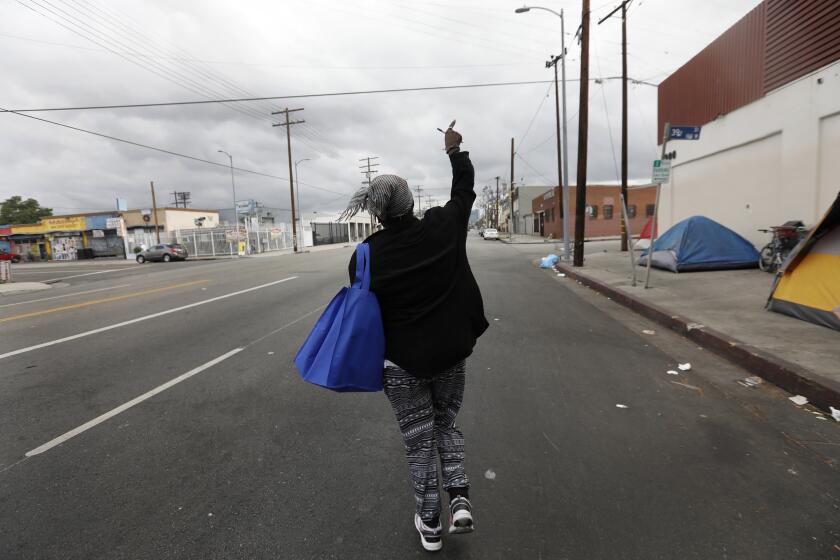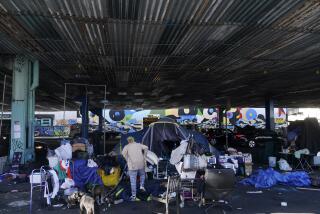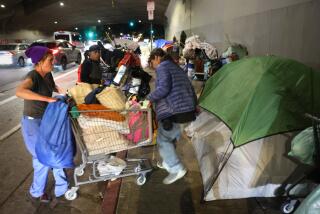Scathing new audit finds deep operational failures at L.A.’s top homeless outreach agency

The homeless outreach agency that was meant to move hundreds of people from the streets into housing, shelters or treatment for mental illness and substance abuse has failed dramatically to meet the goals of its contract with the city of Los Angeles, according to an audit released Wednesday by Controller Ron Galperin.
The audit found that, despite having more than doubled its staff of outreach workers in the last two years, the Los Angeles Homeless Services Authority missed seven of nine goals during the 2017-18 fiscal year and five of eight last fiscal year.
“The goals that were set by the city are not unreasonable,” Galperin told The Times. “Quite frankly, they are [setting a] pretty low bar to begin with. If you can’t meet the low bar, that’s a problem.”
Outreach workers were supposed to place into permanent housing 10% of the homeless people they assessed. But in the fiscal year that ended in June, they placed only 4%, the audit reported. The goal was 20% for placing people in shelters, but they achieved only 14%.
The discrepancies were greater for referrals to treatment: 6% for substance abuse and 4% for mental health. Both had goals of 25%.
At a news conference Wednesday, Galperin called those results “shocking.”
The authority’s “outreach is fundamentally limited because it is reactive instead of being proactive,” he said. “Much of the outreach has been consumed with responding to calls about homeless encampments throughout the city of Los Angeles.”
First in a series: Big Mama and her neighbors live in a homeless encampment in Los Angeles. Through a special housing initiative they’ll soon have the opportunity to move into apartments.
LAHSA, as the authority is commonly known, issued an equally biting response that was distributed in writing at the news conference.
Peter Lynn, the authority’s executive director, called the audit misleading, saying it studied only measures that are ill-suited to determining the effectiveness of homeless outreach and looked at only the fraction of LAHSA’s system that is covered by the city contract.
“It ultimately says nothing about LAHSA’s outreach efforts, which contacted record numbers of our homeless neighbors in the year it studied,” he said in the statement.
Heidi Marston, the authority’s chief program officer, gave a more measured reaction. Marston said federal privacy rules prevented LAHSA from accurately reporting mental health and substance abuse referrals. As a result, she said, the agency no longer uses those goals.
“The report did a good job of pointing out where some of the gaps were,” she said after the news conference, “and we agree that proactive outreach is the way to go as opposed to reactive outreach.”
The main problem with the system, she said, is that it is unbalanced — heavy on engagement with homeless people, but short on shelters and housing.
“We have 30,000 people who have said to us: ‘Yes, we want resources. Yes, we want shelter.’ But yet we don’t have anything to offer them,” Marston said.
While attributing some of the shortfalls to the underlying shortage of affordable housing and treatment resources in the city, the audit criticized the city for setting fuzzy goals that weren’t linked to the scale of the homelessness crisis and knocked the authority for not being able to meet them.
In its 2019 count, LAHSA reported that there were close to 60,000 homeless people living in the county, with more than 36,000 of them in the city. All but about 25% live on the streets.
Galperin said the audit, which began last year, took months to complete “partly because getting accurate and consistent numbers from LAHSA has been a challenge.”
The authority, according to the audit, “lacks a rigorous performance review process for its outreach activities. Moreover, data-driven decisions about the deployment of resources are not made because the information is neither timely nor accurate.”
LAHSA provided the controller’s office with four different versions of its outreach numbers, each one significantly different, Galperin said. A chart in the audit showed the percentage of homeless people placed into shelters dropping from 64% in the first version to 19% in the last.
The authority attributed those changes to the loss of some records during a transition to a new data system.
The audit also faulted a report by the authority that it placed 21,000 people into permanent housing last year. Not only did the number include placements made by other agencies, such as the U.S. Department of Veterans Affairs, it included duplicates by counting individuals or families that fell in and out of homelessness during the year, the audit said.
Federal judge refuses to derail settlement, but says area businesses may file a claim if they can show it adversely affected their property.
The report also faulted LAHSA’s participation in cleanups of homeless encampments by the city’s Bureau of Sanitation for contributing to its failings with outreach. The authority estimated that cleanups accounted for 67% of its outreach time in the city.
“In many cases, they are required to talk with people that are already working with homeless service providers,” the report said. The city should “rethink its outreach policies and more sufficiently find a balance between a proactive outreach strategy and an effective response to ‘hot-spot’ encampments.”
The audit sharply criticized the goals set by the city in its contract with LAHSA.
The goal that 25% of homeless people with a substance abuse disorder would be connected to appropriate treatment “supplies no indication about what the 25% target represents,” it said. “Even if LAHSA had met its 25% target, only 167 … would have received substance abuse treatment,” it said.
In a written response, Lynn said those numbers reflected a flaw in the audit. “Metrics around mental health and substance use are not appropriate … when evaluating outreach,” the statement said.
Marston added that outreach is “about how well we interact with them. It’s about the quality of the interaction.”
Galperin said the city and authority should recast goals that are understandable and specify the number of people expected to receive assistance, rather than using a percentage. LAHSA also should adopt a data-driven outreach system modeled after the CompSTAT policing model used by police departments across the country, including the LAPD.
Marston said the authority is already doing that at the city’s Unified Homeless Response Center, and that it has set better goals for data collection and reporting.
With the infusion of sales tax dollars from Measure H, the city-county outreach system has grown from fewer than 300 workers to nearly 800. They include teams employed by the homeless authority and its contractors, and teams fielded by the Los Angeles County departments of Health Services and Mental Health.
The city contributed $3.5 million from its general fund in the 2017-18 fiscal year to LAHSA and $6.8 million last year, the audit said. County contributions increased from $13 million to $31 million.
Finally, in light of the city’s chronic shortage of shelters, the report urged both the city and county to do more to provide short-term resources, such as restrooms, showers, storage facilities and waste services to ameliorate living conditions on the street.
“There are things we can do immediately,” Galperin said. “You look at when civil emergencies happen around the world. This is what we have on our streets right how. Unfortunately, the city is not treating it quite as the emergency it is.”
It’s unclear whether any changes to the way LAHSA operates will be made as a result of the audit. Changes to its contract with the city are likely, but there were no concrete proposals for how the authority’s burden of staffing encampment cleanups could be reduced.
Mayor Eric Garcetti, through a spokesman, issued a statement saying that he would review the audit.
“If we’re going to solve this crisis, we need ideas and input from all our leaders, and we should always be willing to put our strategies under a microscope,” Garcetti spokesman Alex Comisar said.
County Supervisor Janice Hahn said in a statement that the audit highlighted concerns she has had about outreach across the county.
“We need to stop justifying our current approaches and figure out what strategies will actually get the job done,” she said.
But Supervisor Sheila Kuehl defended LAHSA, saying in a statement that the audit did not provide “a full and fair analysis” because it focused on a single city contract.
More to Read
Start your day right
Sign up for Essential California for news, features and recommendations from the L.A. Times and beyond in your inbox six days a week.
You may occasionally receive promotional content from the Los Angeles Times.









